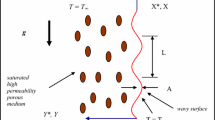Abstract
The aim of upscaling is to determine equivalent homogeneous parameters at a coarse-scale from a spatially oscillating fine-scale parameter distribution. To be able to use a limited number of relatively large grid-blocks in numerical oil reservoir simulators or groundwater models, upscaling of the permeability is frequently applied. The spatial fine-scale permeability distribution is generally obtained from geological and geostatistical models. After upscaling, the coarse-scale permeabilities are incorporated in the relatively large grid-blocks of the numerical model. If the porous rock may be approximated as a periodic medium, upscaling can be performed by the method of homogenization. In this paper the homogenization is performed numerically, which gives rise to an approximation error. The complementarity between two different numerical methods – the conformal-nodal finite element method and the mixed-hybrid finite element method – has been used to quantify this error. These two methods yield respectively upper and lower bounds for the eigenvalues of the coarse-scale permeability tensor. Results of 3D numerical experiments are shown, both for the far field and around wells.
Similar content being viewed by others
References
T. Arbogast, M.F. Wheeler and I. Yotov, Mixed finite elements for elliptic problems with tensor coef-ficients as cell-centered finite differences, SIAM J. Numer. Anal. 34(2) (1997) 828–852.
D.N. Arnold and F. Brezzi, Mixed and nonconforming finite element methods: Implementation, postprocessing and error estimates, RAIRO Modél. Math. Anal. Numér. 19 (1985) 7–32.
J.-L. Auriault, Effective macroscopic description for heat conduction in periodic composites, Internat. J. Heat Mass Transfer 26(6) (1983) 861–869.
J. Bear, Dynamics of Fluids in Porous Media(Dover, New York, 1972).
A. Bensoussan, J.-L. Lions and G. Papanicolaou, Asymptotic Analysis for Periodic Structures(North-Holland, Amsterdam, 1978).
A. Bossavit, Computational Electromagnetism(Academic Press, San Diego, 1998).
F. Brezzi and M. Fortin, Mixed and Hybrid Finite Element Methods(Springer, New York, 1991).
H.S. Carslaw and J.C. Jaeger, Conduction of Heat in Solids(Oxford Univ. Press, Oxford, 1959).
C.M. Case, Physical Principles of Flow in Unsaturated Porous Media(Oxford Univ. Press, New York,1994).
F. Chatelin, Spectral Approximation of Linear Operators(Academic Press, New York, 1983).
J. Douglas, Jr., M. Peszy´nska and R.E. Showalter, Single phase flow in partially fissured media, Transport Porous Media 28 (1997) 285–306.
M.E. Gurtin, Variational principles for linear initial value problems, Quart. Appl. Math. 22(3) (1964) 252–256.
U. Hornung, Homogenization and Porous Media(Springer, Berlin, 1997).
E.F. Kaasschieter, Preconditioned conjugate gradients for solving singular systems, J. Comput. Appl. Math. 24 (1988) 265–275.
E.F. Kaasschieter and A.J.M. Huijben, Mixed-hybrid finite elements and streamline computations for the potential flow problem, Numer. Methods Partial Differential Equations 8 (1992) 221–226.
P.R. King, The use of renormalization for calculating effective permeability, Transport Porous Media 4 (1987) 37–58.
C. Lanczos, The Variational Principles of Mechanics(Dover, New York, 1970).
J.A. Meijerink and H.A. Van der Vorst, An iterative solution method for linear systems of which the coefficient matrix is a symmetric M-matrix, Math. Comp. 31 (1977) 148–162.
Ph.M. Morse and H. Feshbach, Methods of Theoretical Physics(McGraw-Hill, New York, 1953).
J.C. Nédélec, Mixed finite elements in R3, Numer. Math. 35 (1980) 315–341.
M. Panfilov, Macroscale Models of Flow Through Heterogeneous Porous Media(Kluwer Academic, Dordrecht, 2000).
M. Peszy´nska, On a model of nonisothermal flow through fissured media, Differential and Integral Equations 8(6) (1995) 1497–516.
R.A. Raviart and J.M. Thomas, A mixed finite element method for 2nd order elliptic problems, in: Mathematical Aspects of the Finite Element Method, Lecture Notes in Mathematics, Vol. 606 (Springer, New York, 1977) pp. 292–315.
R.F. Ribeiro and R.K Romeu, Computing the effective permeability by finite differences, finite elements, and mixed-hybrid finite elements (1997).
E. Sanchez-Palencia, Non-homogeneous media and vibration theory, in: Lecture Notes in Physics, Vol. 127 (Springer, Berlin, 1980).
G. Strang and G.J. Fix, An Analysis of the Finite Element Method(Prentice-Hall, Englewood Cliffs, NJ, 1973).
A. Trykozko, Analyse de quelques méthodes de maillage adaptif, Électricité de France, Document HI-72/7715, Clamart, France (1991).
A. Weinstein and W. Stenger, Methods of Intermediate Problems for Eigenvalues(Academic Press, New York, 1972).
A. Weiser and M.F. Wheeler, On convergence of block-centered finite-differences for elliptic problems, SIAM J. Numer. Anal. 25 (1988) 351–375.
W. Zijl and M. Nawalany, Natural Groundwater Flow(CRC/Lewis, Boca Raton, FL, 1993).
W. Zijl and A. Trykozko, Numerical homogenization of the absolute permeability using the conformal-nodal and the mixed-hybrid finite element method, Transport Porous Media (2001) in press.
W. Zijl and A. Trykozko, Numerical homogenization of the absolute permeability tensor around wells(2001) submitted.
Author information
Authors and Affiliations
Rights and permissions
About this article
Cite this article
Trykozko, A., Zijl, W. & Bossavit, A. Nodal and Mixed Finite Elements for the Numerical Homogenization of 3D Permeability. Computational Geosciences 5, 61–84 (2001). https://doi.org/10.1023/A:1011621529611
Issue Date:
DOI: https://doi.org/10.1023/A:1011621529611



